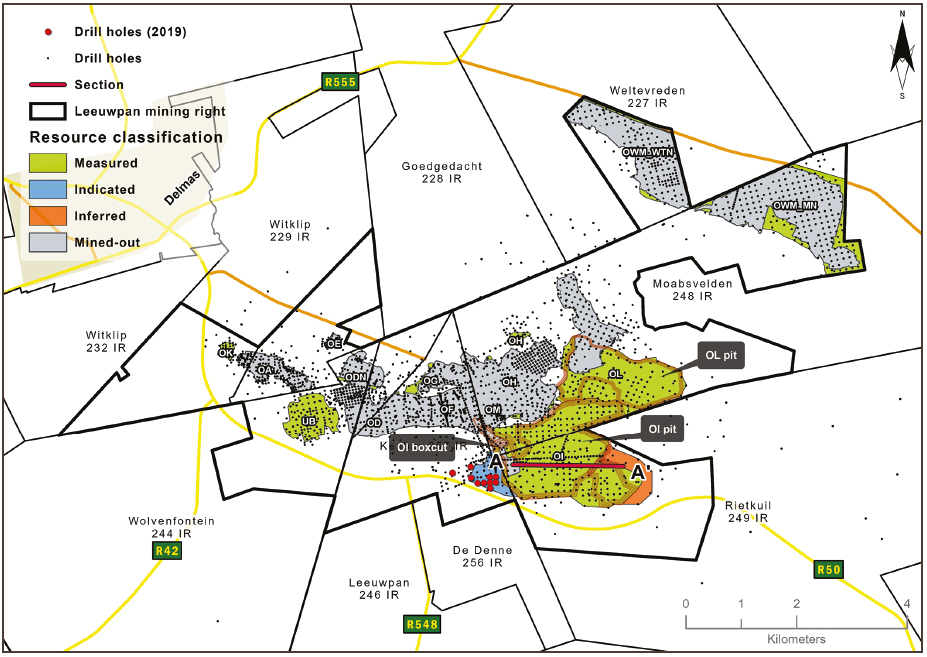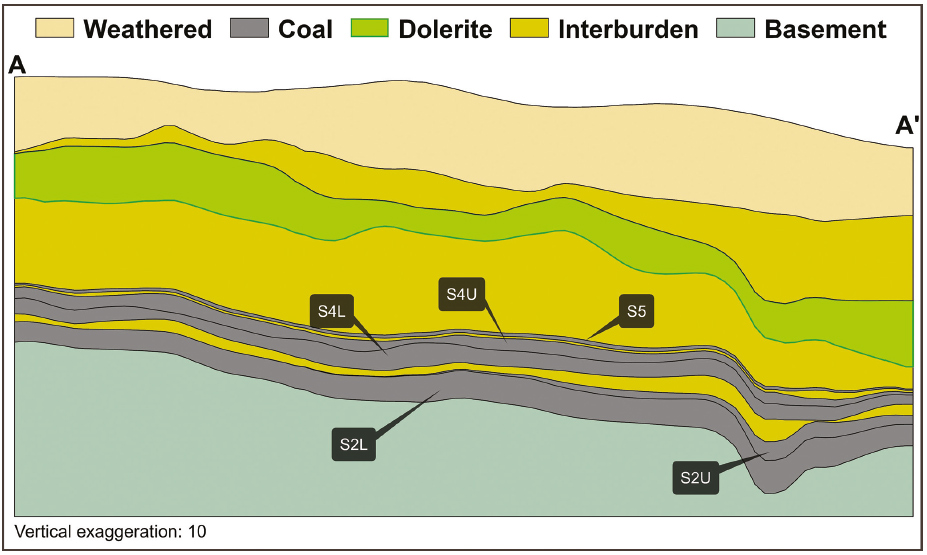Integrated report 2019

Leeuwpan mine is in the Delmas coalfield, on the western border of the Witbank coalfield. Leeuwpan, in the Victor Khanye local municipality in Mpumalanga province, is 10km south-east of the town of Delmas, 80km east of Johannesburg and 70km south-east of Pretoria. It lies alongside the R50 hard-topped secondary road and is serviced by a rail track that includes a rapid load-out station.
Leeuwpan is an opencast operation with various Reserves, in various pits, mined simultaneously. Current mining operations are on the OJ (depleted in 2018), OL and OWM Reserves with the introduction of OI Reserves. The OI box-cut was completed in September 2018 and first coal was produced in Q1 2019. The mine uses trucks and shovels for mining-related operations. We estimate that the mine will be in production until 2031, with the mining right lapsing in 2039. Leeuwpan supplies domestic and export markets. The mine is equipped with a rapid rail load-out station, which is the preferred means of coal offtake, although road transport is accommodated.
Leeuwpan has two dense medium separator (DMS) plants that beneficiate export thermal coal and a crush-and-stack (CS) plant that handles selectively mined thermal coal, mainly for the local market. The second DMS plant, commissioned in 2016, is operated by Fraser Alexander (FA DMS). The original DMS plant produced a 5 700kcal/kg product whose market ended in Q4 2018, necessitating the change to a 5 300kcal/kg product. The FA DMS, on the other hand, was geared to produce a 5 200kcal/kg product. The CS produced a 4 200kcal/kg product. All three plants produce mainly thermal coal.
Leeuwpan has 4 152 boreholes in the mining right area covering 4 269ha but only 2 215 falls in the Resource blocks. These boreholes were drilled in various campaigns and not all boreholes are reliable hence only 871 have been used in geological modelling. All Measured Resources at Leeuwpan are currently at 100m x 100m drill spacing.
Table 64: Leeuwpan operation history
| Date range | Company | Material notes | ||
| Up to 1988 | Southern Sphere | 262 borehole records exist for this period. Leeuwpan was sold to Kumba in 1988 | ||
| 1988 - 2006 | Kumba Resources | Exploration began in 1990. Box-cut was commissioned in 1992. Rights were ceded to Exxaro Resources in 2006 | ||
| 2006 - 2019 | Exxaro Resources | Ongoing exploration campaigns focused mainly on operational de-risking drilling programmes |
Figure 26: Leeuwpan coal mine

Two coal seams have been identified at Leeuwpan: top coal seam (TC) and bottom coal seam (BC). BC correlates with the seam 2 (S2) of the Witbank and Highveld coalfields and TC correlates to the seam 4 (S4) and seam 5 (S5). BC qualities are generally higher than TC qualities.
The coal seams at Leeuwpan are primarily interbedded with sandstone, shale and carbonaceous shale. The coal was deposited on glacial sediments of Dwyka tillite which, in turn, were deposited on dolomite of the Transvaal Supergroup. A significant amount of magma intruded as concordant sills of dolerite in the Karoo strata in the Delmas area. Associated with the dolerite intrusion are numerous thin dolerite dyke structures that transgress the stratigraphy. Factors controlling geological and quality continuity are mainly surface weathering, significant variation in seam thickness due to an undulating tillite floor, faulting associated dolerite activity and dolomitic basement, and devolatilisation and weathering due to dolerite intrusions (sills and dykes).
The average total seam thickness at Leeuwpan is 10.9m, with an average raw calorific value of 20.1MJ/kg, raw volatile matter of 18.7% and raw ash content of 31.4% (adb). These qualities require beneficiation for export-quality products.
Samples are named and numbered as per the standard task procedure at Leeuwpan (STP-LP-PO.003) which states that samples should be numbered on the BH core using a wax marker in a different colour to that of the lithology code. The number of samples is recorded on the log sheet as per STP-LP-PO.002. Numbering of the sample tag is written in the order of Reserve BHID/sample number, example, MN971/2.
Samples are split on the lithological contact, if needed, using a chisel and hammer to ensure a clean break. Each sample is put in an individual bag with all contents represented in that interval, ensuring no contamination occurs between materials to be sampled. Should there be any unwanted material in the bag, a comment is made on the sample sheet. Once the sample is in the bag, a tag is attached. Two sample tags are written on plastic sample tags using a permanent marker. One sample tag is placed inside the bag and the second on the outside of the bag when sealed with a cable tie.
In 2014, Bureau Veritas was awarded the coal quality analyses contract for sample preparation and analyses. Raw RD is determined before the sample is crushed to -12.5mm and the 0.5mm fraction is screened out. Raw analysis is done on the +0.5mm -12.5mm material and float-sink analyses performed at float RD: 1.4, 1.5, 1.6, 1.7 and 1.8. Proximate analysis, CV and sulphur are performed on each fraction. All sample preparation is done in accordance with ISO 3909 parts 1 to 5.
Bureau Veritas is SANAS-accredited for analytical work and participates in monthly local and international round-robins.
Table 65: Leeuwpan Coal Resource reporting criteria
| Thickness cut-off (thickness and extraction height considerations) |
Quality cut-offs (adb) | Geological loss | ||
<2m (2014 model) <1m (2015 model and onwards) |
Ash >50% | 5% |
Figure 27: Typical cross-section through Leeuwpan geological model (Moabsvelden)

Geovia MinexTM is used to model the coal seams and estimate in-situ Coal Resources at Leeuwpan. Coal Resource block sizes vary, and boundaries are determined by farm boundaries, coal qualities, coal thicknesses, infrastructure and geological structures. The model generates grid surfaces for the upper and lower boundaries of the coal seams from borehole intersection points. The grid surfaces of the top of a seam and bottom of the seam are then subtracted from each other to estimate the thickness of the seam. The washability qualities associated with each sample are also converted from point to grid data using the same growth algorithm technique. The method gives smooth surfaces which replicate the regional trends of geology, while reflecting local anomalies.
The Coal Resource classification methodology is fundamentally based on SANS 10320 and considers borehole spacing, type of boreholes and structural complexity of the Resource.
Table 66: Leeuwpan Coal Resource estimation criteria
| Item | Description | |||||
| Database | Borehole database | acQuire | ||||
| Data datum | Cape LO29 | |||||
| Number of boreholes used for Resource estimation | 871 boreholes | |||||
| Validation | Conducted using queries in acQuire and Excel | |||||
| Data compositing and weighting | Geovia MinexTM | |||||
| Model | Previous model date | 2016 | ||||
| Last model update | 2018 | |||||
| Geological modelling software | Geovia MinexTM | |||||
| Estimation technique | Growth algorithm | |||||
| Grid mesh size | 20m x 20m | |||||
| Scan distance | 2 000m | |||||
| Data boundary | 200m | |||||
| Model build limits | Upper: limit of weathering and topography/collar Lower: basement/Dwyka |
|||||
| Model outputs | Roof, floor and thickness grids generated for structureRaw quality gridsWash quality grids | |||||
| Changes to modelling process | None |
Table 67: Leeuwpan Coal Resource classification criteria
| Category | Type of boreholes | Borehole spacing | Structurally complex areas | BH/ha | ||||||||
| Measured | Cored boreholes with applicable coal qualities | 0m - 100m | Resource blocks limited by faults, dolerite sill breakthrough and devolatilisation Geotechnical risks associated with faulting, dykes, sill and weathering - infill drilling |
1.1 | ||||||||
| Indicated | Cored boreholes with applicable coal qualities | 100m - 200m | Resource block limited by devolatilisation and coal depth - infill drilling | 0.6 | ||||||||
| Inferred | Cored boreholes with applicable coal qualities | 200m - 1 000m | Resource block limited by devolatilisation - infill drilling | 0.2 |
Table 68: Leeuwpan Coal Resource and Reserve statement
| Category | 2019 (Mt) |
2018 (Mt) |
Difference in tonnes (Mt) |
Difference (%) |
Reason for changes | |||||
| Measured | 92.8 | 101.1 | (8.3) | (8) | Mining depletion (8.3Mt) | |||||
| Indicated | 2.6 | 2.6 | — | — | ||||||
| Inferred | 3.6 | 3.6 | — | — | ||||||
| Total Coal Resources | 99 | 107.3 | (8.3) | (8) | ||||||
| Proved | 45.9 | 53.7 | (7.8) | (14) | The decrease is primarily due to mining depletion (6.1Mt) and the disposal of areas due to dolerite activity (1.4Mt). Change in material allocation as a result of beneficiation quality changes (0.1Mt) | |||||
| Probable | 6.1 | 6.2 | (0.1) | (1) | ||||||
| Total Coal Reserves | 52.1 | 59.8 | (7.8) | (13) |
Rounding of figures may cause computational discrepancies.
Table 69: Leeuwpan RPEEE considerations
| Item | Criteria | Considered | Comment | ||||||
| Geological data | Data validated and signed off by competent person | Yes | |||||||
| Geological model | Geological model considered and signed off | Yes | Seam depth, seam thickness >2m (2014 model) and seam thickness >1m (from 2015 model). <50% ash content, coal qualities are reported on an air-dry basis | ||||||
| Structural model | Structural model considered and signed off | Yes | |||||||
| Mining | Mining assumptions considered and defined | Yes | OC | ||||||
| Assurance | Minimum tier 1 assurance (Exxaro governance) | Yes | 2018 | ||||||
| Economic evaluation | Concept-level exploitation with economic and mining assumptions, including geotechnical and geohydrological assumptions | Yes | LoM exploitation study | ||||||
| Environmental | Reasonable demonstration that environmental approvals can be obtained within the context of local, regional and national governmental legislation | Yes | Current required approvals in place, except for OI West where an integrated water use licence has been granted for infrastructure. Approval for mining is pending | ||||||
| Tenure | Formal tenure must be demonstrated with reasonable demonstration that a mining right approval can be obtained within the context of local, regional and national governmental legislation | Yes | Mining right valid to 2040 | ||||||
| Infrastructure | Assumptions used should be reasonable and within known/assumed tolerances or have examples of precedence | Yes | Current infrastructure | ||||||
| Market | A potential market for the product with a reasonable assumption that it is sustainable | Yes | Current market |
Scheduling of the Reserve is determined using mine scheduling applications from XPAC, which is the same software used to develop the LoM plan schedule.
There is no difference between Resource grids and Reserve grids. Grid validation for Leeuwpan is conducted by checking for negative thicknesses, ensuring contact integrity and checking energy ratios to ensure progressive increase down the wash tables.
At Leeuwpan generally, the Measured Resources are converted to Proved Reserves, except for UB, where it is classified as a Probable Reserve because of additional modifying factors such as low volatiles and with a limited market for this particular quality of coal. Indicated Resources are converted to Probable Reserves as is the case for OI West.
Table 70: Leeuwpan production figures
| Actual 2018 |
FC 2019 |
Actual 2019 |
FC 2020 |
FC 2021 |
||||||
|---|---|---|---|---|---|---|---|---|---|---|
| RoM (Mt) | 6.65 | 6.83 | 6.5 | 7.09 | 7.09 |
Table 71: Leeuwpan modifying factors considered in converting Coal Resources to Coal Reserves
| Modifying factors | Value | ||
| Geological loss | 5% | ||
| Average thickness cut-off | 1.0m | ||
| Quality cut-offs | N/A | ||
| Mining loss | 25% for S5 and 5% for all other seams | ||
| Boundary pillar | 100m | ||
| Dilution | 0 | ||
| Contamination | 5% on DMS plants and 1% on CS plant | ||
| Mining recovery efficiency | 5% (CS) and 5% (DMS bypass) | ||
| Planned average slope angles | 45 degrees. For highwall stability, soft material is mined at least one strip ahead of hard material and coal-mining activities | ||
| Practical plant yield | 90% DMS and 90% FA DMS with slimes loss on DMS of 9% and 15% on FA DMS | ||
| Strip ratio cut-off | N/A | ||
| Environmentally sensitive areas | OJ (environmentally sensitive areas such as wetlands) | ||
| Legal | OWM and OJ | ||
| Social | Socially sensitive areas in the mining right (such as graveyards) are excluded from Reserves in the reserving process | ||
| Geohydrological | Pit floor was taken into consideration to minimise water handling in the pit face |
The OI West portion of the Coal Reserve is classified as Probable as Leeuwpan is still awaiting approval of the integrated water use licence (IWUL).
Geological challenges (eg seam floor undulation and presence of sill and dykes) are addressed through proactive infill drilling, grade control and mine planning.
Groundwater management and pit de-watering requires constant monitoring to ensure that it does not influence production.
A delay in an Eskom powerline relocation poses a risk to mine scheduling of the OL pit and the execution of the LOM plan. The LOM plan has been revised to accommodate this relocation delay and maintain production stability.
Achieving the higher than previously experienced overburden volumes, as scheduled, is critical to obtain the mine's planned production.
DMS bypass project to improve plant throughput on RoM with in-spec raw qualities. Leeuwpan is running a number of operational excellence initiatives to improve productivity, including:
The Leeuwpan integrated operations centre is intended to increase operational throughput by optimising the value chain. Having an across-the-board view of operations, it will be possible to make timely decisions for better control of interruptions across the value chain.